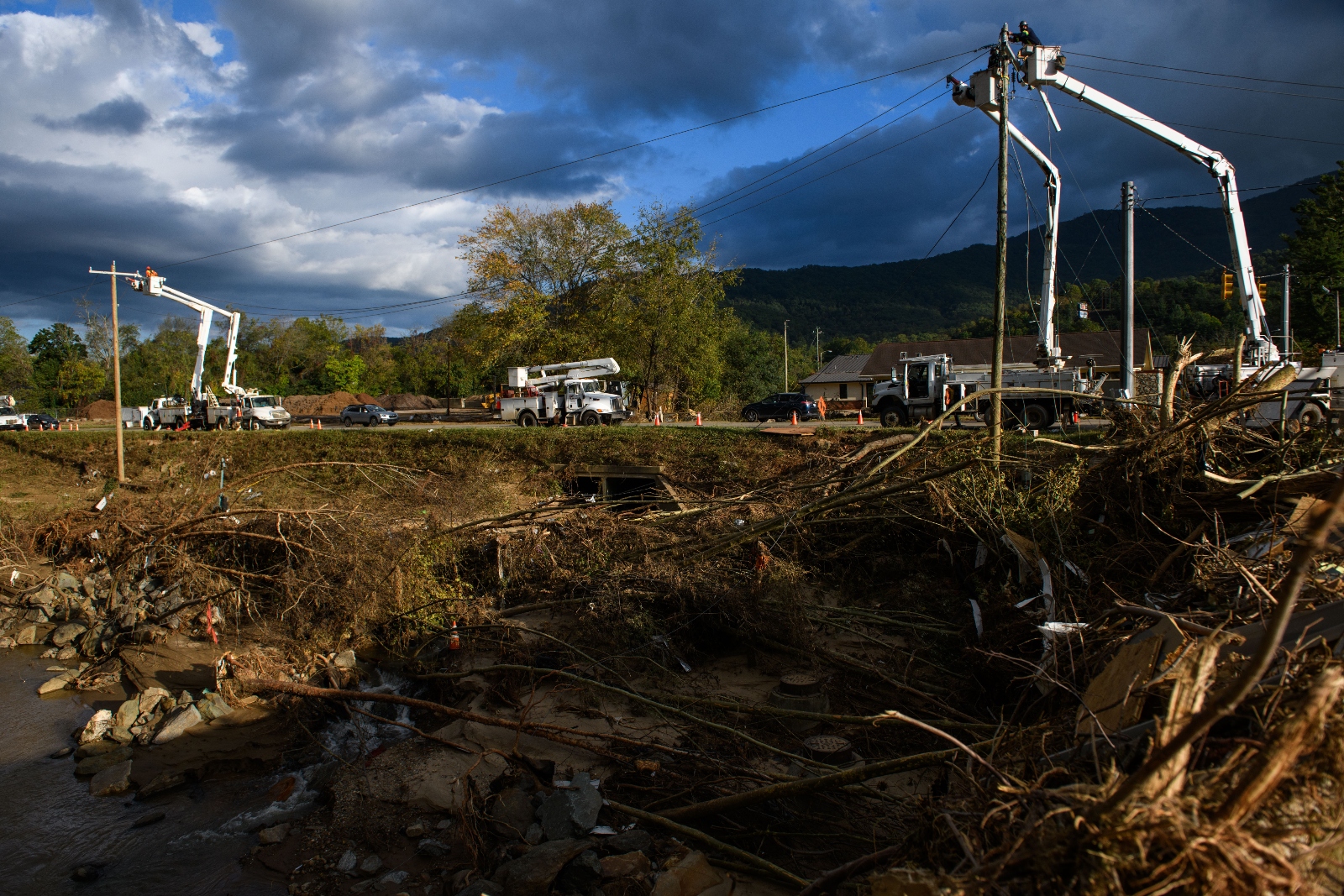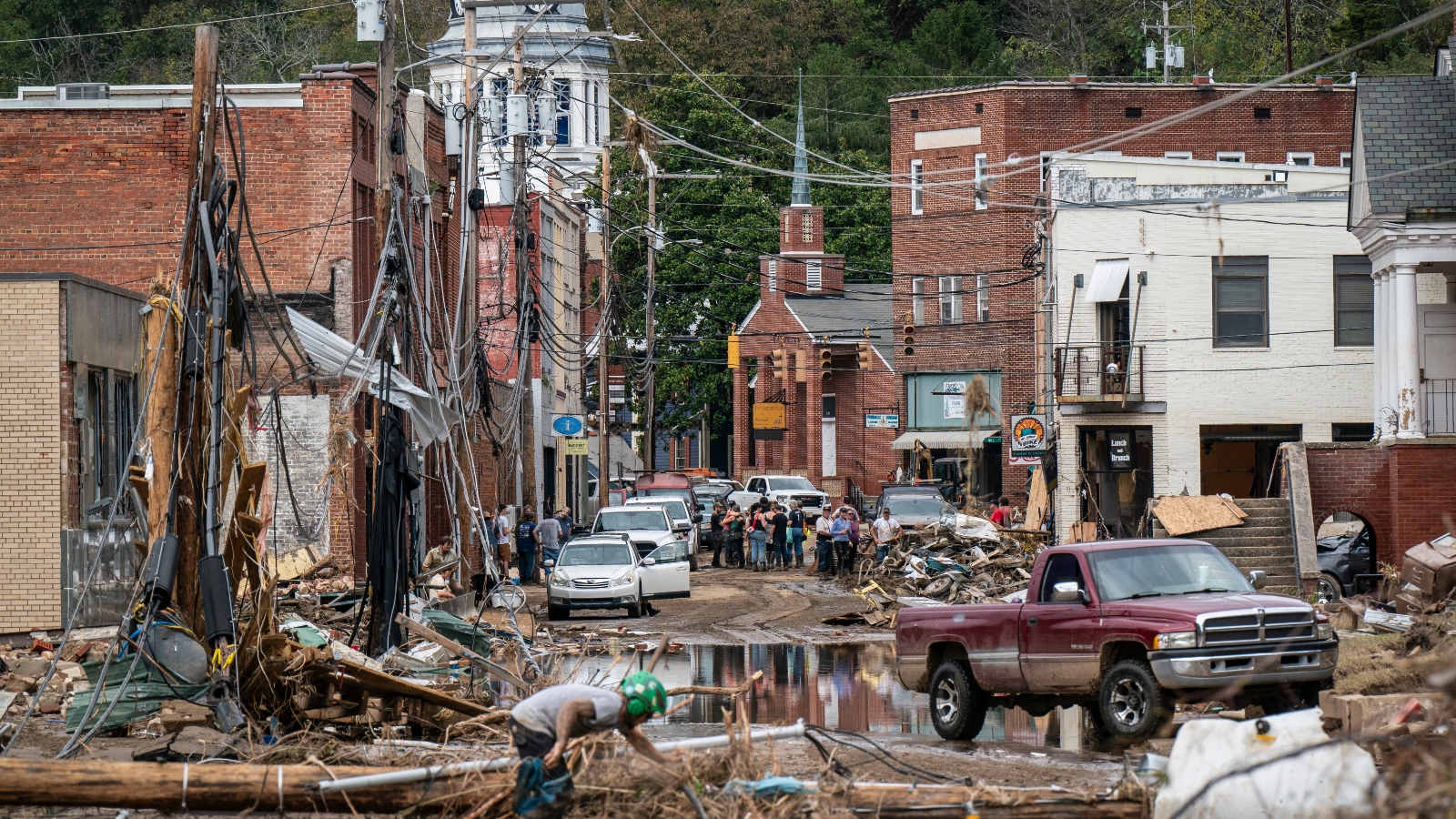
By the time Hurricane Helene moved hundreds of kilometers inland on September 27, it was downgraded to a tropical storm. But Helene remained unusually stretched and strong, fueled by the warm waters in the Gulf of Mexico. The storm brought high winds and catastrophic flooding, knocking out power to more than 2 million Duke Energy customers in the Carolinas, and tore through a region of the country not generally seen as vulnerable to hurricane damage: the Mountain South. Asheville, North Carolina, the hardest-hit city, even appeared on lists of “climate havens” considered relatively safe from the natural disasters whose impacts are exacerbated by global warming.
In the course of the next week, more than 50,000 utility workerswith crews from 41 US states and Canada, begin the heroic work of restoring power. In some areas, they even transported power poles by helicopter where roads remained impassable. By Saturday, service had been restored to more than 90 percent of the customers who lost power. But some of the remaining outages may be more difficult to repair, requiring the complete replacement of technically complex power infrastructure equipment. These repairs “will potentially take many weeks,” said Jeff Brooks, a spokesman for Duke Energy.
The unprecedented devastation has brought renewed attention to the problem of ensuring the resilience of America’s power grids in the face of climate change, and to the massive transformation that decarbonisationelectrification, and bring a projected growth in demand for electricity. Worldwide shortages of important electrical equipment like transformers and circuit breakers doesn’t make that question any easier to figure out.
Electrical equipment and water do not mix, so heavy flooding poses a serious threat to unprepared power grids. “There was a dramatic miscalculation of risk factors here,” said Tyler Norris, a doctoral fellow at Duke University and former special adviser at the Department of Energy. “So this event should trigger a wide range of new analyzes on the vulnerability of various parts of the power system.”
Among the challenges Western North Carolina faces in rebuilding its grid are its geographic differences from the regions where various solutions have been tested. Norris described the region as “a mountainous area that still has a relatively decent population density.” In low-lying coastal areas more accustomed to hurricanes, for example, some utility companies began moving power lines underground to avoid the problems that hurricane force winds present. But in Duke Energy’s service area, “you have this very distant set of distribution lines that go up into the hills and serve different communities,” Norris continued.
Last week, an early report from North Carolina Congressman Chuck Edwards claimed that 360 substations in North Carolina were “out” due to flooding caused a minor panic among network expertswho were concerned that there simply weren’t enough transformers in reserve in the US to rebuild so many substations.
Transformers are the pieces of electrical equipment needed to move an electrical current from one voltage to another. They are needed on either side of a transmission line – the massive power lines that carry electricity at a high voltage between power plants and the lower voltage distribution lines that power homes and businesses. They are housed in substations, the junctions between the transmission and distribution systems.
It turns out that the crisis was not so bad. Of the 360 substations that were turned off, most “were out because of damage to the transmission system that powers them, not necessarily damage to all of those substations,” said Brooks, the Duke Energy spokesman. But even a handful of destroyed substations is no small matter. At least two sites, the utility company has driven in temporary “mobile substations” that will provide power to nearby communities until the equipment can be repaired.
In normal times, says John Wilson, a vice president at consulting firm Grid Strategies, it takes more than a year to build a new substation from scratch, including drawing up a site-specific design and obtaining the equipment. Rebuilding can be a significantly shorter process when the designs are already complete, and utilities keep some equipment in reserve. But depleting those reserves will only add to the potential bottleneck in the supply chain for future crises.
Global demand for transformers is growing, in part because the transition to renewable energy will require many more sites of power generation than the old fossil fuel-powered system — and each new power plant will need its own equipment. With few transformer manufacturers operating in the US, utilities must wait average 150 weeks for an order to arrive.
While it is unclear whether the storm recovery will be directly hampered by the transformer shortage, it could breathe life into solutions that have recently been proposed. In September, the president’s National Infrastructure Advisory Council recommended that the federal government creates a strategic reserve of transformers to circumvent the industry’s long lead times. And in a report published in August, Grid Strategies recommended that utilities band together in a collective procurement organization—ideally with federal loan support—to place large orders and share the costs. “This will help deal with the construction backlog; right now, manufacturers are reluctant to build new factories to build this equipment in the US or North America because they’re not confident the market will be there,” Wilson said.
Rebuilding the power grid in the areas of Appalachia that were devastated by Helene will finally provide a chance for the utility industry to rethink how the electricity system should be structured. “In areas where there may be more extreme weather events like this, it’s going to be increasingly difficult to maintain remote distribution systems,” Norris said. “And the cost of service is going to go up, and you either have to wade through it or think about other measures, like underground lines, or try to bring load into higher concentration levels so it’s not so far away, or, of course, to think more about distributed energy systems and backup power.”
There are ways to build network resilience that can be implemented at a more local level – although they are expensive. One is the concept of microgrids – local electrical networks that are disconnected from the wider power system. Norris said this concept could be expanded further by allowing individual homes and businesses to power themselves with rooftop solar when the grid is down. Most solar arrays are not configured to produce power when there isn’t a wider grid to feed them into, to protect the line workers who are repairing power lines from a live current. But this can be prevented by a technique called solar islanding, which effectively disconnects the solar array from the grid.
Last week, Duke Energy used one such micro gridin the flooded resort town of Hot Springs, North Carolina, to the downtown lights for days with just batteries and solar power. For towns like Hot Springs, microgrids can be much more than temporary patches.






